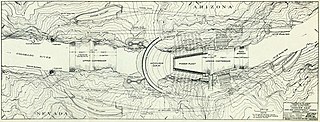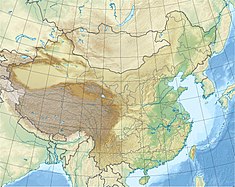
The Xiluodu Dam is an arch dam on the Jinsha River, i.e. the upper course of the Yangtze in China. It is located near the town of Xiluodu in Yongshan County of Yunnan Province but the dam straddles into Leibo County of Sichuan Province on the opposite side of the river. The primary purpose of the dam is hydroelectric power generation and its power station has an installed capacity of 13,860 MW. Additionally, the dam provides for flood control, silt control and its regulated water releases are intended to improve navigation downstream. Construction on the dam and power station began in 2005 and the first generator was commissioned in 2013, the last in 2014. It is operated by China Yangtze Power and is currently the third-largest power station with the fourth-tallest dam in the world.

Nuozhadu Dam is an embankment dam on the Lancang (Mekong) River in Yunnan Province, southwest China. The dam is 261.5 m (858 ft) tall, and creates a reservoir with a normal capacity of 21,749,000,000 m3 (17,632,000 acre⋅ft) at a level of 812 m (2,664 ft) asl. The purpose of the dam is hydroelectric power production along with flood control and navigation. The dam supports a power station with nine generators, each with generating capacity of 650 MW. The total generating capacity of the power station is 5,850 MW. Construction on the project began in 2004; the dam's first generator went online 6 September 2012 and the last generator was commissioned in June 2014. The construction and management of the project was implemented by Huaneng Power International Ltd., which has a concession to build, own and operate hydroelectric dams on China's stretch of the Mekong River.

The Laxiwa Dam is an arch dam on the Yellow River in Qinghai Province, northwest China. It is 32 km (20 mi) downstream of the Longyangxia Dam and 73 km (45 mi) upstream from the Lijiaxia Dam. The main purpose of the dam is hydroelectric power generation and it supports the largest station in the Yellow River basin. The facility generates power by utilizing six turbines, each with a generating capacity of 700 MW, totaling to a capacity of 4,200 MW.

The Ankang Dam is gravity dam on the Hanjiang (Han) River near Ankang in Shaanxi Province, China. The main purpose of the dam is hydroelectric power production along with other purposes such as flood control and navigation. The dam withholds a 2,580,000,000 m3 (2,091,640 acre⋅ft) reservoir which supplies water to its powerhouse located on the right toe. The power station contains 4 x 200 MW generators for a total installed capacity of 800 MW. On the dam's surface adjacent to the power house are five controlled spillway chutes. The dam also houses five mid-level openings and four base openings for discharging water as well.

The Sanbanxi Dam is a concrete face rock-fill embankment dam on the Yuan (Qingshui) River in Jinping County, Guizhou Province, China. The dam houses a hydroelectric power station with 4 x 250 MW generators for a total installed capacity of 1,000 MW. Construction began in 2001 and was complete by 2006.

The Baishan Dam is an arch-gravity dam on the Second Songhua River near the town of Baishanzhen, Huadian, Jilin Province, China. The purpose of the dam is hydroelectric power generation and flood control. The dam supplies water to five turbine-generators in two different powerhouses for an installed capacity of 1,500 megawatts (2,000,000 hp) while it can also control a design 19,100 cubic metres per second (670,000 cu ft/s) flood. Additionally, it has a 300 megawatts (400,000 hp) pumped-storage hydroelectric generation capacity. It is named after Baekdu Mountain, near the city of Baishan.

The Fengman Dam is a concrete gravity dam 20 km (12 mi) from Jilin City on the Second Songhua River in Jilin Province, China. The main purposes of the dam are hydroelectric power generation and flood control. Construction of the dam began in 1937 and was complete in 1953. Northeast China Grid Company Limited, the dam's owner, plans on rebuilding it in the future.

The Liyuan Dam is a concrete-face rock-fill dam on the Jinsha River on the border of Yulong County and Shangri-La County, Yunnan Province, China. The dam will have an associated hydroelectric power station with a 2,400 MW power station containing 4 x 600 MW generators. Construction on the river diversion for the dam began in 2008. It began to impound its reservoir in November 2014 and on December 28, 2014 the first generator was commissioned. The second generator was commissioned in July 2015.

The Pengshui Dam is an arch dam on the Wu River in Wulong County, Chongqing, China. The dam provides water to a 1,750 MW hydroelectric power station containing 5 x 350 MW generators. Construction on the dam began in September 2003 and the power plant was operational in 2008.

The Yantan Dam is a gravity dam on the Hongshui River near Dahua County, Guangxi China. The main purpose of the dam is hydroelectric power production and it has an associated 1,210 MW power station consisting of 4 x 302.5 MW Francis turbine-generators.

The Wanjiazhai Dam is a gravity dam on the Yellow River on the border of Pianguan County, Shaanxi Province and Inner Mongolia Autonomous Region, China. The main purpose of the dam is water supply for the Wanjiazhai Water Control Project along with peak hydroelectric power generation. Construction on the dam began in 1994, the first generator went online in 1998 and the last in 2000.

The Wujiangdu Dam is an arch-gravity dam on the Wu River south of Zunyi, Guizhou Province, China. The purpose of the dam is hydroelectric power generation, flood control and navigation. The dam's power stations contain five generators for a total installed capacity of 1,130 MW.

The Danjiangkou Dam is a concrete gravity dam on the Han river near Danjiangkou in Hubei Province, China. The original dam was constructed between 1958 and 1973. The dam creates a large Danjiangkou Reservoir.

The Houziyan Dam(Chinese: 猴子岩水电站) is an under construction embankment dam on the Dadu River in Danba County, Sichuan province, China. When completed, the dam will be 223.5 m (733 ft) tall and withhold a reservoir with a normal capacity of 662,000,000 m3 (536,692 acre⋅ft). It will also support a power station with a 1,700 MW capacity; containing 4 x 425 MW generators.

The Jinping-I Dam also known as the Jinping-I Hydropower Station or Jinping 1st Cascade, is a tall arch dam on the Jinping Bend of the Yalong River in Liangshan, Sichuan, China. Construction on the project began in 2005 and was completed in 2014. Its power station has a 3,600 MW capacity to produce between 16 and 18 TW·h annually. Supplying the power station is a reservoir created by the 305-meter-tall arch dam, the tallest in the world. The project's objective is to supply energy for expanding industrialization and urbanization, improve flood protection, and prevent erosion.

The Huanglongtan Dam is a concrete gravity dam located on the Du River, a tributary of the Han River. It is located 25 km (16 mi) west of Shiyan in Hubei Province, China. The main purpose of the dam is hydroelectric power generation but it also provides for flood control. It was constructed between 1969 and 1976 and support a 510 MW power station.

The Malutang Dam is a concrete-face rock-fill dam (CFRD) on the Panlong River in Malipo County, Yunnan Province, China. The primary purpose of the dam is hydroelectric power generation and the power plant was constructed in two stages. Stage I consists of a 40 m (131 ft) tall gravity dam which diverted water through a 3,460 m (11,352 ft) long tunnel to a 100 MW above ground power station downstream. Construction on Stage I began in 2002 and the first of 50 MW Francis turbine-generators was commissioned in October 2004, the second in January 2005. Stage II was the construction of a 156 m (512 ft) tall CFRD 200 m (656 ft) downstream of the Stage I dam. Stage II's power station contains three 100 MW Francis turbine generators. Construction on Stage II began in August 2005 and the reservoir began to fill in October 2009. In December 2009, the first 100 MW generator was operational and the last two by May 2010. Malutang Dam's reservoir submerged the Stage I dam but the Stage II intake tower receives water for both stages, allowing Stage I to continue to operate.

The Panjiakou Dam is a concrete gravity dam on the Luan River in Qianxi County, Hebei Province, China. The primary purpose of the dam is to provide water for the cities of Tianjin and Tangshan, located to the south. The dam also provides flood control and its power plant has an installed capacity of 420 MW which includes a 270 MW pumped storage power station.

The Suofengying Dam is a concrete gravity dam on the Wu River, 44 km (27 mi) northwest of Guiyang in Guizhou Province, China. It is located 35.5 km (22 mi) downstream of the Dongfeng Dam and 74.9 km (47 mi) upstream of the Wujiangdu Dam. The primary purpose of the dam is hydroelectric power generation and it supports a 600 MW power station. Construction on the dam began on 26 July 2002 and on December 18 of that year, the river was diverted. Pouring of roller-compacted concrete into the dam's body began on 14 January 2004 and in June, the dam began to impound its reservoir. On 18 August, the first generator was operational and the last two in 2005. The 121.8 m (400 ft) tall dam creates a reservoir with a capacity of 201,200,000 m3 (163,115 acre⋅ft). The dam's power station is located on its right bank and contains three 200 MW Francis turbine-generators.

The Lianhua Dam is a concrete-face rock-fill dam on the Mudan River in Linkou County of Heilongjiang Province, China. It is located about 95 km (59 mi) north of Mudanjiang. The 71.8 m (236 ft) tall dam serves several purposes to include hydroelectric power generation, flood control and water supply for irrigation. The dam withholds a large 4,180,000,000 m3 (3,390,000 acre⋅ft) capacity reservoir and supports a 550 MW power station. Construction on the dam began in November 1992 and its first 137.5 MW Francis turbine-generator was operational in December 1996. Two more generators were commissioned on 12 December 1997 and the remaining generator was commissioned on 28 September 1998. It is the first large modern water conservancy project in Heilongjiang. The dam's reservoir displaced 40,000 people and will serve as the lower reservoir for the Huanggou Pumped Storage Power Station when it is complete.









